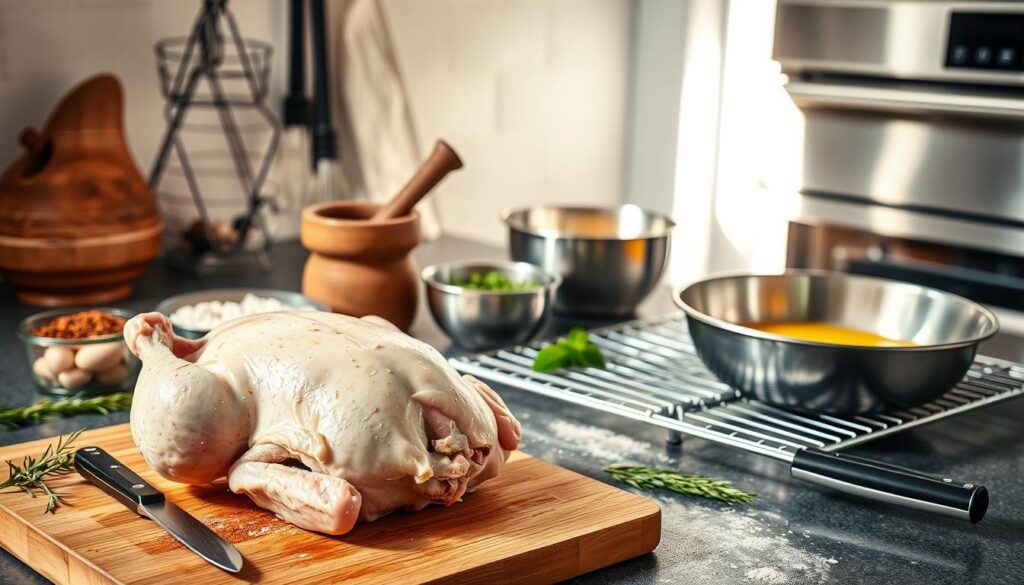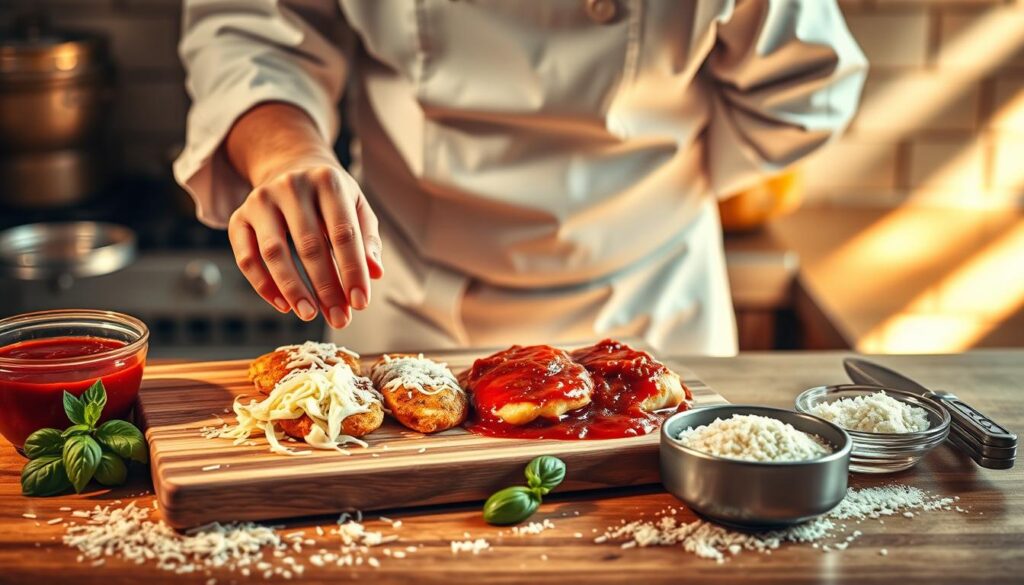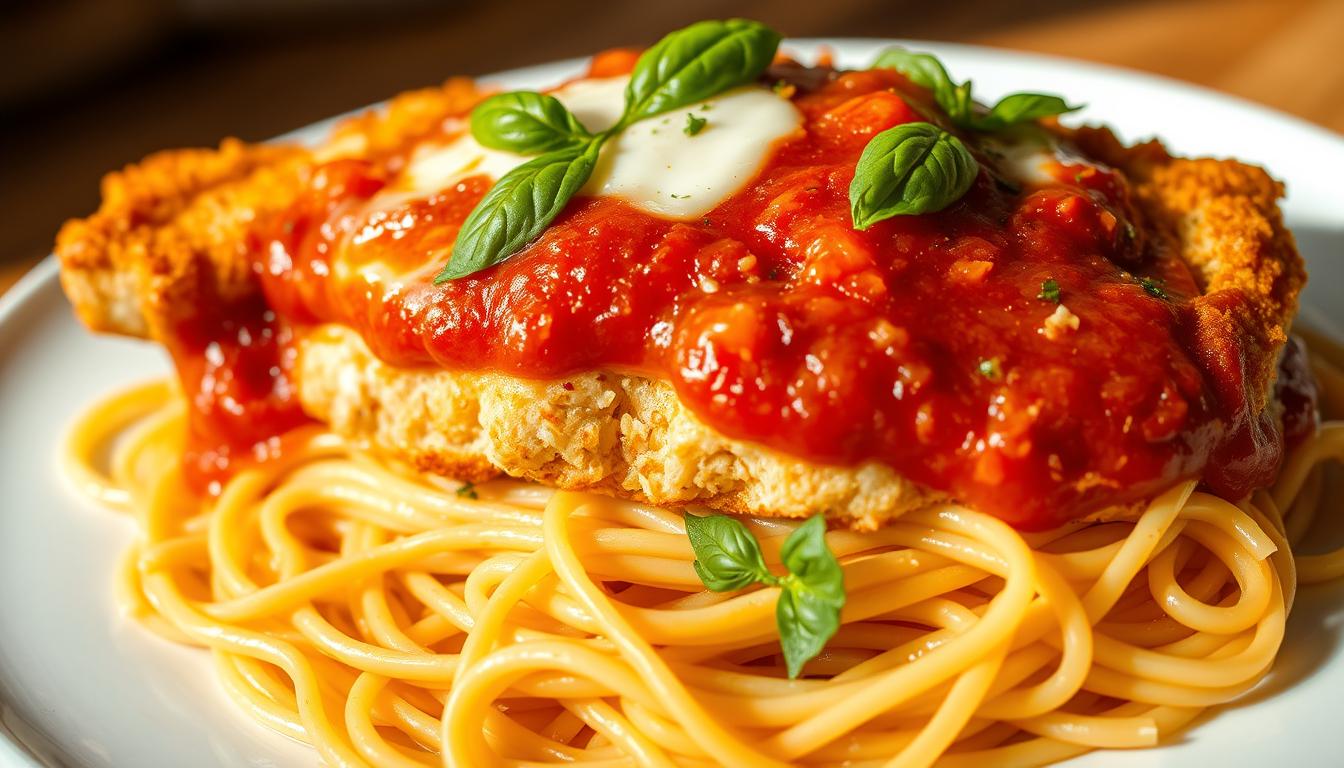Growing up in an Italian-American household, I learned Chicken Parmesan was more than food. It was a celebration of family, tradition, and passion for cooking. The sizzle of golden chicken, the smell of marinara sauce, and the cheese melting together create a special experience.
Chicken Parmesan is at the heart of Italian cuisine in America. About 75% of Americans love Italian-American dishes, making this recipe a favorite in many homes. Each bite shares a story of immigration, adaptation, and the amazing flavors that come from blending cultures.
Whether you’re an experienced cook or just starting out, this dish offers a fun culinary adventure. It connects you to the rich traditions of Italian-American cooking.
Key Takeaways
- Chicken Parmesan represents a beloved Italian-American culinary tradition
- The dish typically takes about 45 minutes to prepare and cook
- A standard recipe serves 4-6 people
- Proper breading and cooking techniques are key for perfect results
- The dish offers a rich, comforting dining experience
The Italian-American Heritage of Chicken Parmigiana
Chicken parmesan is a favorite in Italian-American cuisine. It shows a journey from Italy to America, through food. This dish tells of immigration, change, and creativity in cooking.
Origins in 20th Century Immigration
Italian immigrants came to New York in the late 1800s. They brought their love for vegetable dishes. But, in America, they found meat and more money to try new things.
- Southern Italian immigrants began arriving in New York in the late 19th century
- Prior diet was mainly vegetables, with eggplant parmigiana being a favorite
- New economic opportunities allowed for meat consumption
Evolution from Eggplant Parmigiana
The dish started from eggplant parmigiana, a Southern Italian classic. The idea of chicken parmesan came from German neighbors and their chicken schnitzel. This mix created a unique Italian-American dish.
Cultural Significance in American Cuisine
Chicken parmesan is more than food; it’s about adapting and innovating. It went from New York homes to restaurants across the country. It shows how Italian-American families made their dishes fit new tastes and ingredients.
The first chicken parmigiana recipes were in the New York Herald in 1953 and the New York Times in 1962. This marked its place in American food history.
Essential Ingredients for Perfect Chicken Parmesan
To make the best breaded chicken, you need the right ingredients. Start with top-notch boneless chicken breasts. Make sure they’re flattened to 1/2 inch for even cooking.
The breading is key for a crispy outside. You’ll need:
- 1/2 cup all-purpose flour
- 1 beaten egg
- 1 cup panko breadcrumbs
- 1/2 cup grated Parmesan cheese
- 1 teaspoon dried basil
- 1 teaspoon dried oregano
Choose a rich tomato sauce for flavor. Rao’s marinara sauce is a great choice. For the cheese, use mozzarella and Parmesan to get that classic melt.
Pro tip: Use fresh mozzarella (about 8 ounces) sliced thin for the best texture. Mix half of the Parmesan into the breading and save the other half for topping.
Don’t forget 1/4 cup olive oil for frying. Add garlic powder and black pepper for extra taste.
Remember, the quality of your ingredients directly impacts the final taste of your Chicken Parmesan!
Mastering the Breading Technique
Creating the perfect breaded chicken needs precision and technique. The crispy coating turns an ordinary chicken dish into a restaurant-quality masterpiece. Learning the breading process will make your Chicken Parmesan go from good to extraordinary.
Professional chefs know that getting a crispy coating is more than just dipping chicken in breadcrumbs. The three-step dredging process is key for that golden, crunchy exterior. This makes breaded chicken irresistible.
The Three-Step Dredging Process
- Flour Coating: Start by patting chicken breasts dry with paper towels. Pound the chicken to an even ½-inch thickness for consistent cooking.
- Egg Wash: Dip the floured chicken completely in beaten eggs, ensuring full coverage.
- Breadcrumb Layer: Press the chicken firmly into breadcrumbs, using one hand for wet ingredients and another for dry to maintain a clean process.
Tips for Achieving Perfect Coating
- Use one hand for wet ingredients (eggs) and another for dry ingredients (breadcrumbs) to prevent clumping
- Press breadcrumbs firmly onto the chicken to create a thick, even layer
- Allow breaded chicken to rest for 5-10 minutes before cooking to help the coating adhere
Common Breading Mistakes to Avoid
Avoid these pitfalls when preparing your breaded chicken:
- Not drying the chicken thoroughly before breading
- Skipping the flour step, which helps the egg wash stick
- Using breadcrumbs that are too fine or too coarse
- Overcrowding the pan during frying
By mastering these breading techniques, you’ll create a Chicken Parmesan with a perfectly crispy coating. It will rival any restaurant dish.
Proper Chicken Preparation Methods
Preparing chicken is key to making perfect Chicken Parmesan. The right methods can turn a simple meal into a memorable one. Handling the chicken right makes it tender, flavorful, and cooked just right.

Start by picking top-quality chicken breasts or thighs. Dry each piece with paper towels to get rid of extra moisture. This step helps the breading stick better and makes the outside crispy.
Tenderizing Techniques
Tenderizing chicken is vital for a tasty and tender dish. Here are some good ways to do it:
- Use a meat mallet to pound chicken to an even thickness
- Marinate chicken for enhanced flavor and tenderness
- Consider brining to improve moisture retention
Preparation Checklist
| Step | Technique | Time Required |
|---|---|---|
| Drying | Pat chicken dry with paper towels | 2-3 minutes |
| Tenderizing | Pound to even thickness | 3-5 minutes |
| Marinating | Soak in seasoned liquid | 15-30 minutes |
Pro tip: When tenderizing, aim for a uniform thickness of about ½ inch. This ensures even cooking and prevents dry or undercooked sections. Marinate your chicken for at least 15 minutes, or overnight for deeper flavor infusion.
Remember, great Chicken Parmesan starts with meticulous chicken preparation!
The Art of Sauce and Cheese Selection
Making the perfect Chicken Parmesan starts with picking the right sauce and cheese. Your choices can turn a simple dish into a work of art.
Homemade vs. Store-bought Marinara
You can choose between homemade or store-bought tomato sauce. Homemade marinara brings fresh flavors and lets you control what goes in. Store-bought sauces are quick and taste the same every time.
- Homemade sauce benefits:
- Fresh ingredients
- Customizable flavor profiles
- No preservatives
- Store-bought sauce advantages:
- Quick preparation
- Consistent quality
- Wide variety of brands
Cheese Combinations and Ratios
The classic Chicken Parmesan uses mozzarella and Parmesan cheese. Mozzarella melts well, while Parmesan adds a sharp taste.
- Recommended cheese ratio:
- 70% mozzarella cheese
- 30% Parmesan cheese
- Cheese selection tips:
- Use freshly grated Parmesan for best flavor
- Select full-fat mozzarella for optimal melting
- Consider authentic Parmigiano-Reggiano
Layering Techniques for Best Results
Layering is key to a great Chicken Parmesan. Start with tomato sauce, then breaded chicken, more sauce, and top with mozzarella and Parmesan.
Pro tip: Let the cheese get golden and crispy for the best taste and look.
Cooking Techniques and Temperature Control

Mastering the cooking methods for chicken parmesan is key to a tasty baked pasta dish. Your technique can greatly affect this classic Italian-American favorite. It’s all about getting a crispy outside and keeping the chicken tender and juicy.
When making your chicken parmesan, focus on two main cooking methods:
- Pan-frying for a golden-brown crust
- Oven-baking to finish the cooking
To pan-fry, heat olive oil in a large skillet over medium heat. Aim for a temperature of 350-375°F. Add breaded chicken pieces carefully, making sure they have enough room. Cook each side for 2-3 minutes until the coating is golden brown. For a visual guide, check Mediocre Chef’s for the perfect technique.
After pan-frying, put the chicken in a preheated oven at 400°F. This ensures the chicken is cooked to a safe 165°F while keeping it crispy. Cooking time is about 30 minutes, with 15 minutes per side recommended.
Pro tip: Always let your chicken rest for 5 minutes after cooking. This helps the juices spread, making the chicken moist and flavorful. For different cooking methods, Flavorish Recipes has some creative ideas.
Perfect Pasta Pairing and Presentation
Creating the ultimate baked pasta dish is all about choosing the right pasta and how you present it. In Italian cuisine, the pasta you pick can make your chicken parmesan go from good to. While spaghetti is a classic, there are many other exciting options to try.
Here are some pasta suggestions for your chicken parmesan:
- Rotini: Perfect for capturing chunky marinara sauce
- Penne: Provides excellent sauce-holding capabilities
- Fettuccine: Offers an elegant, classic presentation
- Rigatoni: Creates interesting texture with ridged surface
When cooking your pasta, aim for the perfect al dente texture. Fresh pasta cooks in just one to two minutes. Dried pasta takes about eight minutes. Use tongs to move pasta from boiling water to your sauce for the best flavor.
Presentation is key in Italian cuisine. To serve your chicken parmesan, start with a big bed of pasta. Place the crispy chicken cutlet on top and drizzle with marinara sauce. Add fresh basil leaves and grated Parmesan cheese for a stunning and tasty dish that will wow everyone.
Storage and Reheating Guidelines
Keeping your Chicken Parmesan tasty starts with good food storage. Follow these tips to keep your leftovers safe and delicious.
Storing your Chicken Parmesan in the fridge is key. You can keep it in an airtight container for 3-4 days. Try to keep the chicken, sauce, and pasta separate for better freshness.
“Proper storage is the key to enjoying your Chicken Parmesan beyond the first meal”
Refrigeration Tips
- Cool the dish completely before storing
- Use shallow airtight containers
- Store within two hours of cooking
- Keep refrigerator temperature below 40°F
Freezing Recommendations
- Wrap individual portions in freezer-safe wrap
- Freeze for up to 2-3 months
- Thaw in refrigerator for 12-24 hours before reheating
Reheating Methods
- Oven Method (Recommended):
- Preheat to 350°F
- Heat for 15-20 minutes
- Ensure internal temperature reaches 165°F
- Microwave Option:
- Use medium-high power
- Heat for 1-2 minutes
- Check temperature intermittently
For crispiness, reheat on a wire rack. Add fresh sauce and cheese for the last few minutes to bring back the flavors.
By using these storage and reheating tips, your Chicken Parmesan will stay as tasty as the first time you made it.
Variations and Dietary Adaptations
Exploring recipe variations and dietary adaptations can transform your classic Chicken Parmesan into a versatile dish. It meets diverse nutritional needs. Whether you’re managing dietary restrictions or simply want to experiment, these creative approaches will help you reinvent this beloved Italian-American classic.
Gluten-free enthusiasts can easily modify the recipe by replacing traditional wheat flour and breadcrumbs with alternative ingredients. Consider using:
- Almond flour for breading
- Gluten-free panko breadcrumbs
- Crushed gluten-free crackers
- Cornmeal for a crunchy coating
For health-conscious home cooks, baking offers a lighter alternative to traditional frying. Reduce calories and fat by implementing these recipe variations:
- Bake chicken at 400°F instead of deep-frying
- Use cooking spray to minimize oil usage
- Choose part-skim mozzarella cheese
- Add roasted vegetables for extra nutrition
Vegetarian and vegan adaptations open up exciting culinary possibilities. Substitute chicken with plant-based proteins like:
- Eggplant slices
- Portobello mushrooms
- Tofu steaks
- Seitan cutlets
| Adaptation Type | Key Ingredients | Cooking Method |
|---|---|---|
| Gluten-Free | Almond flour, GF breadcrumbs | Baking or air frying |
| Low-Carb | Chicken, low-carb breading | Oven-baked |
| Vegetarian | Eggplant, tofu | Grilling or baking |
| Dairy-Free | Nutritional yeast, vegan cheese | Oven-roasted |
Remember that successful recipe variations maintain the core flavors and textures of Chicken Parmesan. They accommodate individual dietary needs. Experiment with ingredients and techniques to create a personalized version that suits your lifestyle.
Conclusion
Your journey into Chicken Parmesan shows why it’s a favorite among cooks. It’s easy to make and can be ready in under an hour. This makes it great for any meal, whether it’s a weeknight dinner or a special occasion.
Learning to make Chicken Parmesan is more than just following a recipe. It’s about getting the flavors, textures, and cooking right. Every step, from choosing the right breadcrumbs to getting the crust just right, is important. It all adds up to a dish that honors Italian-American cooking traditions.
Chicken Parmesan is for everyone, whether you’re new to cooking or have lots of experience. You can try different cheeses, breading methods, or even make it vegetarian. The most important thing is to make it your own and enjoy every bite.
Now that you know more about Chicken Parmesan, your cooking will get even better. You’ll be able to make meals that impress everyone. It’s a dish that’s both comforting and fancy, perfect for any occasion.

